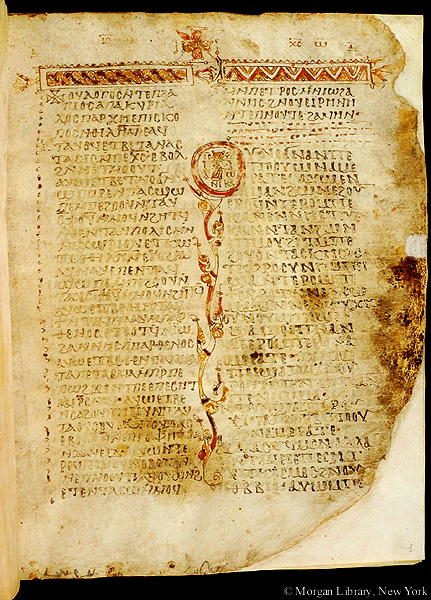
Manuscript homiletic miscellany for Eastertide; written and illuminated in Egypt, before Apr. 3, 855.
Some sewing repairs.
Colophons: 1) fol. 64v: Memorial in Greek, in cryptography: For Deacon Theōdōrōs (probably the same as mentioned in M.583, colophon 2); 2) fol. 148r: Memorial, donation in Coptic: Memorial for the late Papa Apïma (whom van Lantschoot identifies as probably Epïma, the copyist of M.583), monk of the Monastery of St. Michael; donated by Papa Kosma and Deacon Thōter "his brother"; to the same Monastery of St. Michael; 3) fol. 148r: Date of donation (?) in Greek: Barmūda 8, AM 571 (Wednesday, april 3, 855); 4) fol. 148r: Memorial in Greek, in cryptography: For Deacon Kurillou and Apa Kuri "his son;" 5) fol. 148v: Memorial in Coptic: For Deacon Helia; 6) fol. 148v: Copyist (?) in Coptic and Greek: By the priest Gabri.
Colophons 2 and 3 by the same hand as colophons 1 and 2 of M.591.
According to the Coptic Encyclopedia which refers to this manuscript as one of the works attributed to Evodius, the figure and tradition of this person are pure invention.
Early dating terminus given as per L. Depuydt in "Catalogue of Coptic manuscripts in the Pierpont Morgan Library", p. L: "The earliest and latest dates found in Hamuli colophons are AD 822/823 and AD 913/914...Since the Hamuli group is fairly homogeneous, it is reasonable to assume that all manuscripts from Hamuli roughly belong in the period AD 822/823-913/914."
Written area ca. 275 x 199 mm. Divisions: Brown leather tabs fastened to fore-edge of fols. 51, 78, 94, 108 and 141 at major divisions in the codex; ekthesis, initial (sometimes enlarged, sometimes reddened), and paragraphus sign setting off paragraphs.
Script: Upright (title and colophons right-sloping). 10 lines = ca. 79 mm
Superlineation: Non-standard. Punctuation: Raised reddened dotted diple (various shapes); space fillers at ends of paragraphs. Tremas.
Collation: Signed on first and last page of the quire, top inner margin. No quire ornaments, monograms, headlines or catchwords.
Scribes: Gabri (?), Apima, Kurillou, and Kuri.
Decoration: headpieces, tailpiece ornaments, marginal ornaments, initials, paragraphus signs, signatures and page numbers, extended letters. Colors: strong reddish orange (Centroid 35), strong yellow (84).
